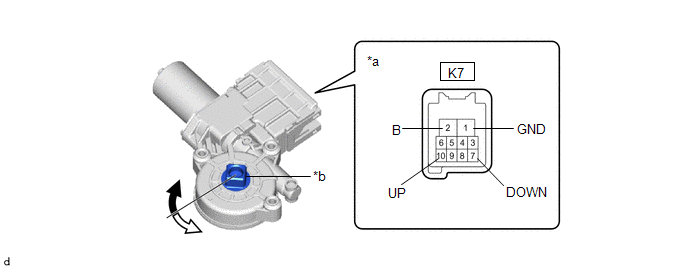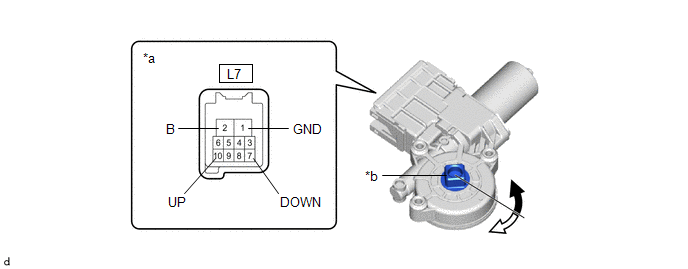Toyota Yaris: Power Window Regulator Motor / Inspection
INSPECTION
CAUTION / NOTICE / HINT
NOTICE:
- Do not apply positive (+) auxiliary battery voltage to any terminals, except terminal K7-2 (B) or L7-2 (B), to avoid damaging the pulse sensor inside the motor.
-
Perform initialization of the power window system after removing, inspecting or replacing the power window regulator motor assembly.
Click here
.gif)
PROCEDURE
1. INSPECT POWER WINDOW REGULATOR MOTOR ASSEMBLY RH
(a) Connect a positive (+) auxiliary battery lead to connector terminal K7-2 (B).

| *a | Component without harness connected (Power Window Regulator Motor Assembly RH) | *b | Motor Gear |
.png) | Clockwise |
.png) | Counterclockwise |
NOTICE:
Do not connect a positive (+) auxiliary battery lead to any terminals other than terminal K7-2 (B) to avoid damaging the pulse sensor inside the motor.
(b) Connect a negative (-) auxiliary battery lead to connector terminals K7-1 (GND) and K7-7 (DOWN) or K7-10 (UP).
(c) Check that the motor gear rotates smoothly as follows:
OK:
| Measurement Condition | Specified Condition |
|---|---|
| Motor gear rotates clockwise |
| Motor gear rotates counterclockwise |
- If the result is not as specified, replace the power window regulator motor assembly RH.
2. INSPECT POWER WINDOW REGULATOR MOTOR ASSEMBLY LH
(a) Connect a positive (+) auxiliary battery lead to connector terminal L7-2 (B).

| *a | Component without harness connected (Power Window Regulator Motor Assembly LH) | *b | Motor Gear |
.png) | Counterclockwise |
.png) | Clockwise |
NOTICE:
Do not connect a positive (+) auxiliary battery lead to any terminals other than terminal L7-2 (B) to avoid damaging the pulse sensor inside the motor.
(b) Connect a negative (-) auxiliary battery lead to connector terminals L7-1 (GND) and L7-7 (DOWN) or L7-10 (UP).
(c) Check that the motor gear rotates smoothly as follows:
OK:
| Measurement Condition | Specified Condition |
|---|---|
| Motor gear rotates counterclockwise |
| Motor gear rotates clockwise |
- If the result is not as specified, replace the power window regulator motor assembly LH.
 Removal
Removal
REMOVAL CAUTION / NOTICE / HINT The necessary procedures (adjustment, calibration, initialization or registration) that must be performed after parts are removed and installed, or replaced during the power window regulator motor removal/installation are shown below...
 Installation
Installation
INSTALLATION PROCEDURE 1. INSTALL POWER WINDOW REGULATOR MOTOR ASSEMBLY (a) Apply MP grease to the sliding and rotating areas of the power window regulator motor assembly...
Other information:
Toyota Yaris XP210 (2020-2025) Reapir and Service Manual: Brake Warning Light does not Come ON
DESCRIPTION The skid control ECU (brake actuator assembly) controls the brake system warning light in the combination meter assembly via CAN communication. CAUTION / NOTICE / HINT NOTICE: After replacing the skid control ECU (brake actuator assembly), perform "Calibration"...
Toyota Yaris XP210 (2020-2025) Owner's Manual: Windshield Wipers
With intermittent wiper Turn the wipers on by pressing the lever up or down. Variable-speed intermittent wipers Set the lever to the intermittent position and choose the interval timing by rotating the ring. With auto-wiper control Turn the wipers on by pressing the lever up or down...
Categories
- Manuals Home
- Toyota Yaris Owners Manual
- Toyota Yaris Service Manual
- Diagnostic Trouble Code Chart
- How to use USB mode
- To Set Speed
- New on site
- Most important about car
Front Seat Belt Pretensioners
The front seat belt pretensioners are designed to deploy in moderate or severe frontal, near frontal collisions.
In addition, the pretensioners operate when a side collision or a rollover accident is detected. The pretensioners operate differently depending on what types of air bags are equipped. For more details about the seat belt pretensioner operation, refer to the SRS Air Bag Deployment Criteria.
